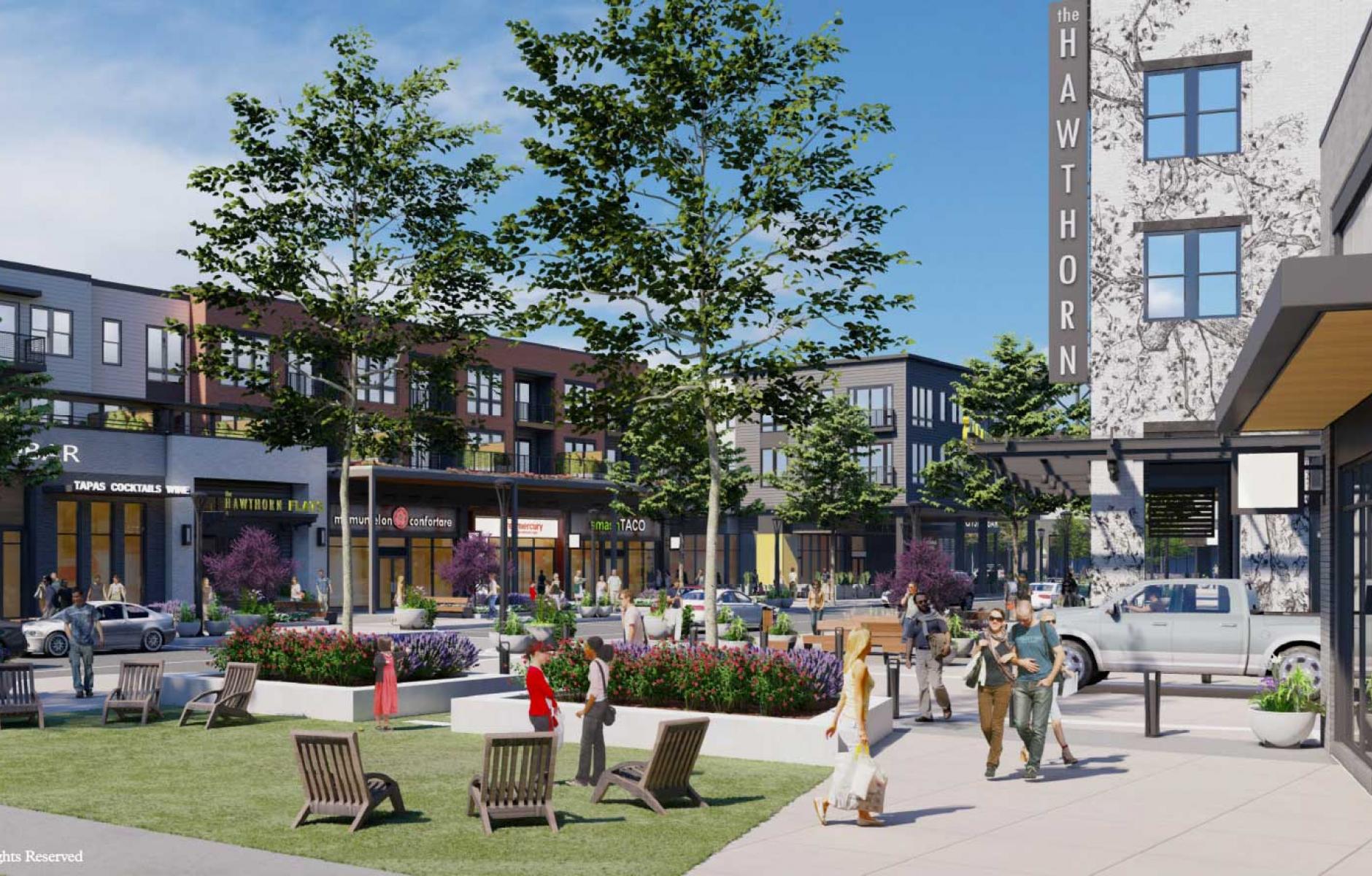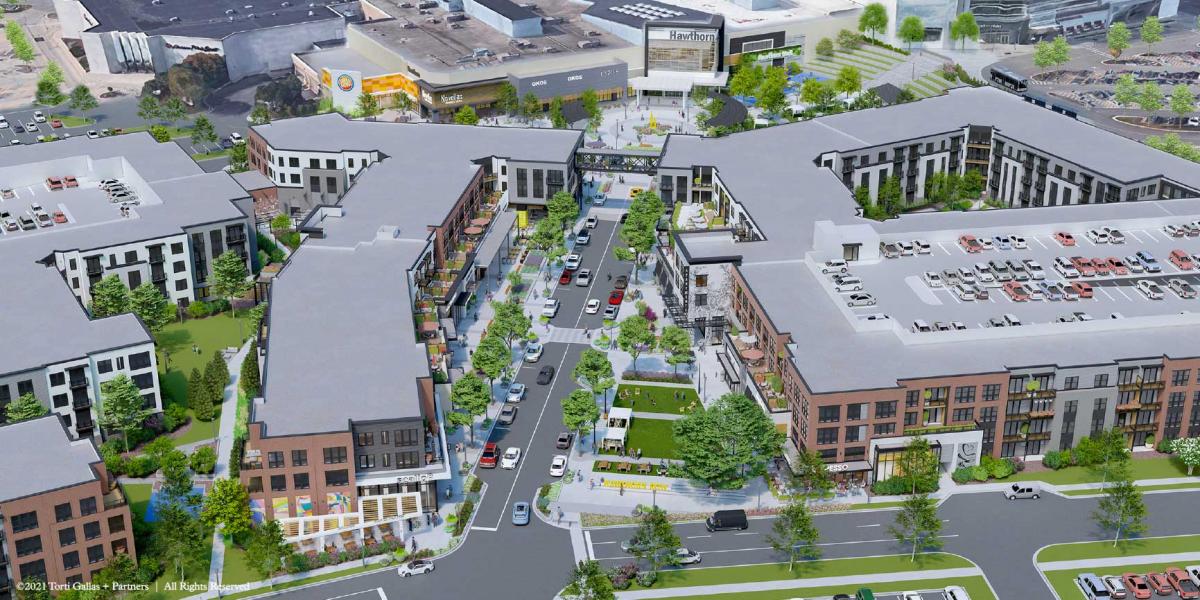
Suburban malls at the crossroads
Over the last several years the retail landscape has changed dramatically—and potentially forever. With numerous store closings, bankruptcies, and changes in shopping habits, the malls we once flocked to in order to satisfy our shopping needs have, in many instances, become vacant relics. Compounded now by the COVID-19 Pandemic, the challenges of malls have become exponential in their severity. These assets within our communities that were once thriving destinations for commerce and social gathering are now in many cases desolate and dark.
Yet another factor contributing to this mounting problem has been the growing consumer preference for open-air, retail lifestyle centers and other commodity retail formats. Shoppers are now seeking convenience and prefer outdoor 24/7 placemaking experiences that are no longer being satisfied by the formulaic nature of anchored shopping malls.
It is becoming clear that our once cherished malls are in need of a re-think. The reimagining of these assets has become a necessity for owners—not only to stay relevant and compete in the marketplace, but also to identify necessary forward-thinking redevelopment strategies that bring additional viable uses and density. It has become less about trying to compete and more about changing the offering.
How did we get here?
It is widely understood that the United States is over-retailed. As of 2018, the US had 23.5 square feet of retail per person. To put this in perspective, countries like the UK, France, Spain, Italy and China were all below 5 square feet per person. Simply stated—we overbuilt retail. “The challenge in the industry is that there's just too much supply,” says Jon Meshel, Senior Vice President of Development at Centennial, a national mall owner. “Cheap money over the last ten years has not only encouraged the supply to grow, but also for landlords to chase tenants on assets that probably should have been written off a long time ago. This cheap money has also exacerbated the opportunity for infighting amongst projects that should have consolidated.”
Instead of slowing down when the market began to see warning signs, the industry kept building more competitive retail formats. “Until the supply issue gets resolved, it's going to continue to be confusing in terms of what projects are going to make sense or not make sense over time,” added Mr. Meshel. This offers little solace for mall owners holding on to underperforming malls across the country.

Winners and losers
As mall owners survey their portfolios and the challenges therein, they must consider many factors in deciding what to do with these assets—from re-positioning to downsizing to demolition and replacement. “We think the supply needs to be edited,” adds Terry Montesi, CEO at Trademark Property. “Most conventional malls in this country have too much indoor shop space today. We think there will be winners and losers. In a major market with 100 shopping centers that are over 100,000 square feet, maybe half of those are sustainable winners.” With this in mind, how is it decided who wins and who loses?
“There is no one size fits all answer,” adds Jon Meshel. “Every asset has its own story. There is also the market story—so there is no obvious answer. Each asset must be examined carefully, independent of what you did that worked 100 miles away—that's, I think, the number one challenge.” Careful consideration must be given to specific market forces and consumer needs to determine the best viable path forward for each mall location.
“The mall industry is set up on replicating the same thing over and over again,” Mr. Meshel continues. “Redeveloping and repositioning is 180 degrees from the replication approach. It requires considering everything independently with its own specific team of people dealing with its own specific host of issues—evaluating what's happening on the campus and what's happening in the market.”
What are The Challenges?
Recognizing that retail demand may still exist in a market—but just less of it, downsizing strategies can be devised to “right-size” the retail offering. The obvious starting point for most malls begins with its anchors. Department stores, long the sales behemoths and engines of the mall, are slowly dying off, yet often present the biggest challenges in terms of ownership and demands. Historically a roadblock to redevelopment, mall anchors, due to their ownership stake in their building and parking field, have not been accommodating to mall redevelopment efforts. “The biggest impediment in mall redevelopment are the anchors,” offers Michael Mindlin, Managing Principal of Mindlin Consulting, a national real estate consulting practice. “I am constantly shocked when we get into conversations with the mall anchors; they know that if the mall dies, they die, yet they are unwilling in the beginning to really have an honest discussion about how to save their store, save the mall and capture the regional market.”
Across the US there are no shortages of malls with “dark” department stores—stores that are vacant due to bankruptcy or store closings. These vacant boxes present obvious opportunities for reinvention. Given their large scale, usually 2-3 stories and 100,000-300,000 square feet, they present challenges for infill or “refill.” However, if demolished, the acreage available for redevelopment not only includes the building footprint, but also includes its enormous parking field. Often, the anchor with its surrounding parking lot offers enough land for the insertion of a neighborhood street grid with developable mixed-use parcels—allowing owners the opportunity to “put land into play.”
“The biggest challenge is when to rethink the mall,” suggests Mr. Meshel. “When we are creating new long term physical obligations, either a new lease with a retailer that involves an investment or a new apartment project that is on the periphery of the site, we must consider the long-term implication for the rest of the campus.” This challenge of what to do, when to do it, and where to do it, must be strategically decided at the outset with a final masterplan in mind—akin to planning chess moves with an end game in mind.
“Up until 2-3 years ago, everyone assumed that if an investment was made, the rest of the campus would keep moving, so long as new capital and new concepts were injected,” added Mr. Meshel. “That strategy proved not to be a cure for a number of different assets and has required much deeper thinking in terms of when you do make an investment, and what happens when the remaining campus eventually goes away. The discussion must involve the masterplan after the initial investment and what's going to happen next.”
This level of calculus takes more time and thought, but in the end, it brings value creation and accommodates future flexibility as it relates to potential market forces. For mall revitalization, both short-term fixes and long-term solutions are necessary. Planning initial redevelopment at a mall site is only meaningful if it is part of a holistic and cohesive evolution. Appropriate mixing of land uses, density and location of “additive” solutions must be contemplated as they relate to mall downsizing and its related parking demand. For this reason, phasing is critical. The upside to combining uses often results in a shared parking benefit given peak demands for the collective uses.
De-tangling the hairball
So, with so many failing malls having so many different stories of how they got there, what are potential solutions for those assets that still have a viable heartbeat? “You need to right-size the retail and reclaim the asphalt,” adds Mr. Mindlin. “We can't afford asphalt in these prime markets anymore. It's just too crazy. You need to add the right mix of non-retail uses and then, we believe, shake it up vigorously. The approach to revitalizing and transforming the shopping experience should involve integrating these non-retail uses directly into the shopping experience.”
All options must be brought to the table in regard to potential non-retail uses. What does the market need? Finding the right mix, or tenant “recipe” is critical. “By integrating an office use, multifamily, entertainment or hotel uses, the remaining retailers can become more vital,” suggests Mr. Montesi. “These new uses do not support it exclusively, but it makes it more vital and provides an anchor to the retail. If done well, it creates a truly multi-faceted experience.”
However, malls are inherently indoor places. As these properties transform over time and become new mixed-use districts, the need for outdoor places becomes critical to their success. Mr. Montesi adds, “I do think placemaking becomes important in these models. It must be in the form of increased outdoor public realm and outdoor seating for restaurants and programmable public spaces. These public spaces support multifamily frontage or office and hotel frontage.” The necessity to consider placemaking and experiential environments is a “value add” proposition. “If done well, there is a synergy of uses and it could be a 1 + 1 equals 3 scenario,” concludes Mr. Montesi.
Jurisdictional participation
What used to be perhaps the largest hurdle in the last decade has become a breath of fresh air. As municipalities are witnessing their malls decline, so are they seeing a decline in their sales tax and property tax generators. Where jurisdictions used to view malls as places from which to extract taxes to support community services, they are now starting to understand them as ecosystems needing careful nurturing and investment. Jurisdictional support for these redevelopments and re-positionings has grown widely. “The jurisdictions need to be very proactive about working with developers in terms of considering flexible ordinances, use changes and incentives,” emphasizes Mr. Meshel. “In this challenging environment the jurisdictions who are working to assist developers are going to end up with the best and most well thought out product.” Mr. Montesi adds, “Smart municipalities will get ahead of this and give tax abatement, tax reduction and other assistance to save the asset—instead of losing 80 percent of their community’s mall they may only lose 30 percent. Even if the mall had a TIF (tax-increment financing district) 10-20 years ago, it will likely need another one.”
To this end, Public/Private Partnerships have become more prevalent in recent years. The notion of “we all have vested interests in the future success of these assets within our communities” has become a unifying theme amongst both developers and jurisdictions. Allowing for alternate uses, increased density and relaxed height and signage restrictions are potential outcomes from this collaboration in many localities. “We are finding that City governments in the last five years or so are finally getting it,” agrees Mr. Mindlin. “They are beginning to understand that their biggest tax base in their community is about to die. Whereas ten years ago they may have been anti-development and didn't want to work collaboratively with a large developer, we are now finding most of the cities today are very savvy and their city managers and staff are well educated in this arena. They are very aware of the collaborative need and they are fabulous partners to work with.”
Conclusion
Our practice has seen a notable uptick in mall repurposing commissions over the last several years. Through this we have discovered that every asset is different and requires its own holistic and strategic approach—both short-term and long-term. The revitalization of malls has challenges, but they are not insurmountable. These challenges offer great opportunities to craft reinvigorated neighborhoods for our next generation. Our communities can be made better by recognizing changing patterns in our society and being proactive through adapting to societies’ shifting needs. Evolution is necessary.





